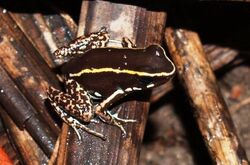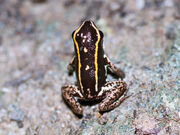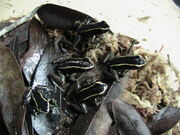No edit summary |
(changed status to least concern) Tags: Visual edit apiedit |
||
| (10 intermediate revisions by 3 users not shown) | |||
| Line 8: | Line 8: | ||
|weight = 2 grams |
|weight = 2 grams |
||
|diet = Insectivorous |
|diet = Insectivorous |
||
| − | |status = |
+ | |status = Least Concern |
|iucn = 3.1 |
|iucn = 3.1 |
||
|kingdom = |
|kingdom = |
||
| Line 17: | Line 17: | ||
|genus = ''[[Phyllobates]]'' |
|genus = ''[[Phyllobates]]'' |
||
|species = ''P. lugubris'' |
|species = ''P. lugubris'' |
||
| − | |distrib = |
+ | |distrib = Nicaragua, Costa rica, Panama |
|distrib image = |
|distrib image = |
||
}} |
}} |
||
| − | The '''lovely poison dart frog''', '''''Phyllobates |
+ | The '''lovely poison dart frog''', '''''Phyllobates lugubris''''', is a species of poison dart frog found in Costa Rica, Nicaragua and Panama. The lovely poison dart frog is amongst the smallest and least-toxic of the ''Phyllobates ''genus and is one of the northernmost poison dart frogs. |
==Poison== |
==Poison== |
||
| + | The lovely poison dart frog is the least toxic of the lethal ''[[Phyllobates]]'' species. Its skin secretes pumiliotoxin A, the most toxic of the three pumiliotoxin types. Pumiliotoxin A, like other pumiliotoxins, functions by blocking muscle contractions, which can cause cardiac arrest and respiratory failure. ''P. lugubris ''contains a surprisingly high amount of pumiliotoxin for a frog of its size; thus touching a wild specimen can have serious and possibly life-threatening consequences. |
||
| + | |||
| + | Pumiliotoxin is deadly in high concentrations. Pumiliotoxin is weaker than allopumiliotoxin and especially batrachotoxin, with a lethal dose of 2 mg (''P. lugubris'' carries about three-quarters of a milligram). There are three different types of this toxin A, B and C. Toxins A and B are significantly more toxic than C. Pumiliotoxins affect the body because they interfere with muscle contraction in the heart and skeletal muscle. The toxin works by affecting the calcium channels. Some of the symptoms of pumiliotoxins are partial paralysis, having difficulty moving, being hyperactive and in some cases it can result in death. |
||
| + | ==Description== |
||
| + | [[File:Phyllobates_Lugubris_02.jpg|thumb|left|Wild specimen.]]The lovely poison dart frog is the smallest species in the ''Phyllobates ''genus, reaching 2.5 centimetres in length. Unlike in some other dendrobatid species, there is little or no sexual dimorphism in ''P. lugubris'', though females may be slightly larger than males. |
||
| + | |||
| + | Unusually for a poison dart frog, ''P. lugubris ''is not particularly vivid. The body and flanks of the frog are typically chocolate brown with two yellow or white dorsal stripes. The limbs are off-white and flecked with brown, and the belly is normally black with a thin reticulum of yellow. ''P. lugubris ''is also a unique poison dart frog in that there is no real variation between populations. Minor differences in pattern exist between individuals, but no distinct colour morphs have been discovered as to date. |
||
| + | |||
| + | ''P. lugubris ''is entirely terrestrial and thus lacks the toepads present in other dendrobatids. |
||
| + | |||
| + | ==Reproduction== |
||
| + | ''Phyllobates lugubris ''lives individually in the wild, another feature that makes it unique for its genus. As such, there are no large breeding gatherings. Small groups of individuals may congregate around breeding sites, but this is different from the breeding gatherings of other poison dart frogs. |
||
| + | |||
| + | [[File:Phyllobates lugubris in amplexus|thumb|300px|right|Amplexus.]]Males are not as territorrial as those of other dendrobatids, but they will squabble over females. The call is a beautiful, bird-like trill akin to the call of ''[[Phantasmal poison dart frog|Epipedobates tricolor]]''. Females are attracted to the males with the most rapid calls in any given group. They may fight to mate with the male in question. Male and female ''P. lugubris'' may or may not engage in maxillary amplexus prior to egg deposition. The eggs are laid in the leaf litter and guarded by the male. As the leaf litter is prone to drying, the male will moisten the eggs with his urine every hour or so. Once the eggs hatch approximately two weeks after being fertilized, the tadpoles slither up over the male's back and cling tightly to him in an organic ball. The male transports the tadpoles to puddles on the forest floor where he deposits them. He then guards the tadpoles until they turn into froglets and become independant. |
||
| + | |||
| + | ==In captivity== |
||
| + | [[File:Phyllobates_Lugubris_03.jpg|thumb|left|A group of captive lovely poison dart frogs.]]The lovely poison dart frog is not as common in captivity as the other ''Phyllobates ''species, but it is kept as a pet. ''P. lugubris'', like the other ''Phyllobates ''species, requires a fairly large vivarium, but in its case a tall vivarium is not reccomended as the frogs rarely climb more than a few inches above ground level. ''P. lugubris ''require a high level of humidity and a temperature range of 25-28 degrees Celsius. Although wild individuals are solitary, captive ''lugubris ''can be quite sociable. |
||
[[Category:Poison dart frogs]] |
[[Category:Poison dart frogs]] |
||
[[Category:Pet amphibians]] |
[[Category:Pet amphibians]] |
||
Latest revision as of 21:24, 3 March 2016
| Lovely poison dart frog | |
|---|---|
 | |
| Physical description | |
| Binomial name | Phyllobates lugubris |
| Habitat | Tropical rainforest |
| Lifespan | 6-15+ years |
| Average Size | 2.5 cm (1.0 in) |
| Average weight | 2 grams |
| Diet | Insectivorous |
| Conservational Status | |
| Status | Least Concern |
| IUCN status | 3.1 |
| Scientific classification | |
| Phylum | Chordata |
| Class | Amphibia |
| Order | Anura |
| Family | Dendrobatidae |
| Genus | Phyllobates |
| Species | P. lugubris |
| Distribution | |
| Distribution of species | Nicaragua, Costa rica, Panama |
The lovely poison dart frog, Phyllobates lugubris, is a species of poison dart frog found in Costa Rica, Nicaragua and Panama. The lovely poison dart frog is amongst the smallest and least-toxic of the Phyllobates genus and is one of the northernmost poison dart frogs.
Poison
The lovely poison dart frog is the least toxic of the lethal Phyllobates species. Its skin secretes pumiliotoxin A, the most toxic of the three pumiliotoxin types. Pumiliotoxin A, like other pumiliotoxins, functions by blocking muscle contractions, which can cause cardiac arrest and respiratory failure. P. lugubris contains a surprisingly high amount of pumiliotoxin for a frog of its size; thus touching a wild specimen can have serious and possibly life-threatening consequences.
Pumiliotoxin is deadly in high concentrations. Pumiliotoxin is weaker than allopumiliotoxin and especially batrachotoxin, with a lethal dose of 2 mg (P. lugubris carries about three-quarters of a milligram). There are three different types of this toxin A, B and C. Toxins A and B are significantly more toxic than C. Pumiliotoxins affect the body because they interfere with muscle contraction in the heart and skeletal muscle. The toxin works by affecting the calcium channels. Some of the symptoms of pumiliotoxins are partial paralysis, having difficulty moving, being hyperactive and in some cases it can result in death.
Description

Wild specimen.
The lovely poison dart frog is the smallest species in the Phyllobates genus, reaching 2.5 centimetres in length. Unlike in some other dendrobatid species, there is little or no sexual dimorphism in P. lugubris, though females may be slightly larger than males.
Unusually for a poison dart frog, P. lugubris is not particularly vivid. The body and flanks of the frog are typically chocolate brown with two yellow or white dorsal stripes. The limbs are off-white and flecked with brown, and the belly is normally black with a thin reticulum of yellow. P. lugubris is also a unique poison dart frog in that there is no real variation between populations. Minor differences in pattern exist between individuals, but no distinct colour morphs have been discovered as to date.
P. lugubris is entirely terrestrial and thus lacks the toepads present in other dendrobatids.
Reproduction
Phyllobates lugubris lives individually in the wild, another feature that makes it unique for its genus. As such, there are no large breeding gatherings. Small groups of individuals may congregate around breeding sites, but this is different from the breeding gatherings of other poison dart frogs.

Phyllobates lugubris in amplexus
Amplexus.
Males are not as territorrial as those of other dendrobatids, but they will squabble over females. The call is a beautiful, bird-like trill akin to the call of Epipedobates tricolor. Females are attracted to the males with the most rapid calls in any given group. They may fight to mate with the male in question. Male and female P. lugubris may or may not engage in maxillary amplexus prior to egg deposition. The eggs are laid in the leaf litter and guarded by the male. As the leaf litter is prone to drying, the male will moisten the eggs with his urine every hour or so. Once the eggs hatch approximately two weeks after being fertilized, the tadpoles slither up over the male's back and cling tightly to him in an organic ball. The male transports the tadpoles to puddles on the forest floor where he deposits them. He then guards the tadpoles until they turn into froglets and become independant.
In captivity

A group of captive lovely poison dart frogs.
The lovely poison dart frog is not as common in captivity as the other Phyllobates species, but it is kept as a pet. P. lugubris, like the other Phyllobates species, requires a fairly large vivarium, but in its case a tall vivarium is not reccomended as the frogs rarely climb more than a few inches above ground level. P. lugubris require a high level of humidity and a temperature range of 25-28 degrees Celsius. Although wild individuals are solitary, captive lugubris can be quite sociable.